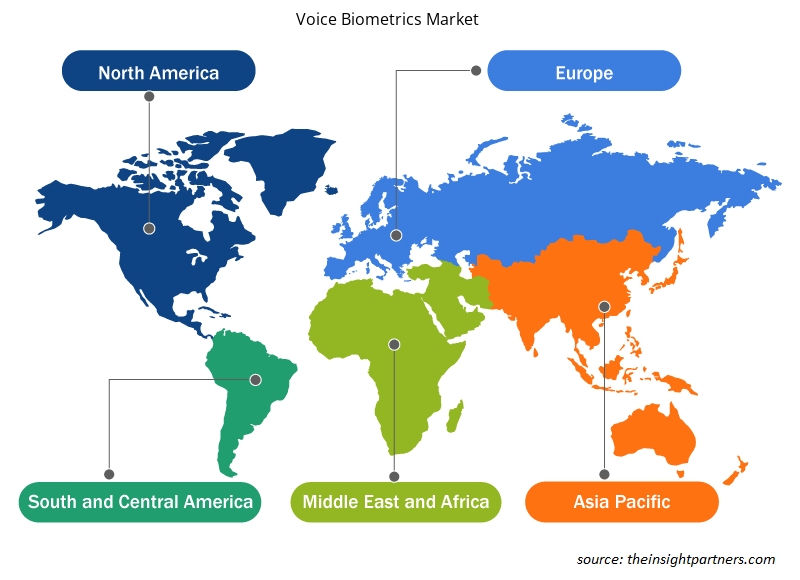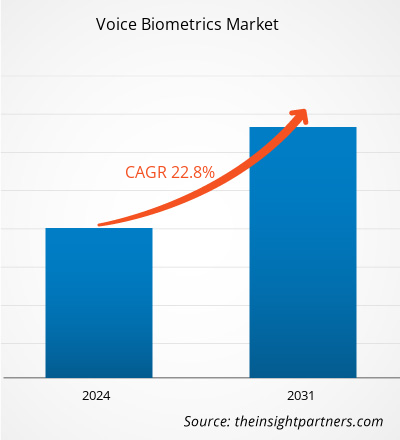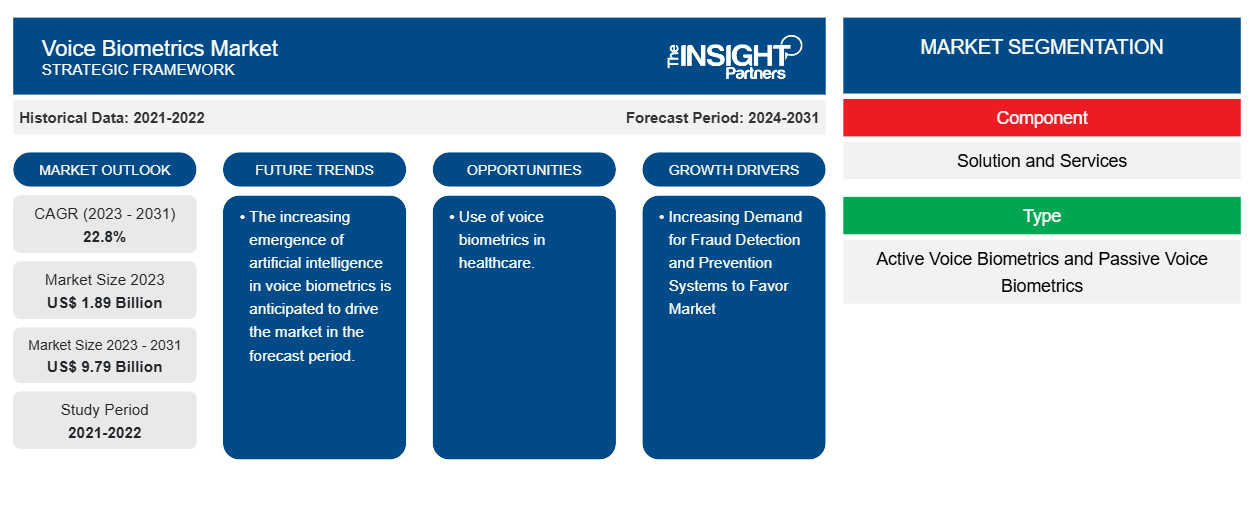Se prevé que el tamaño del mercado de la biometría de voz alcance los 9.790 millones de dólares en 2031, frente a los 1.890 millones de dólares en 2023. Se espera que el mercado registre una CAGR del 22,8 % durante el período 2023-2031. Es probable que la creciente demanda de sistemas de detección y prevención de fraudes y de autenticación de voz en aplicaciones móviles y bancarias sigan siendo tendencias e impulsores clave del mercado.
Análisis del mercado de la biometría de voz
El mercado de análisis de biometría de voz está ganando terreno de manera significativa. Este crecimiento se atribuye al creciente sistema de detección y prevención y a la creciente demanda de autenticación de voz en aplicaciones de banca móvil. Además, se prevé que la creciente adopción de la biometría de voz en la industria de la salud y la creciente aparición de la IA en la biometría de voz generen diversas oportunidades en el mercado de la biometría de voz.
Descripción general del mercado de biometría de voz
La tecnología de biometría de voz valida la identidad de un hablante. También se conoce como reconocimiento de voz, reconocimiento de orador, impresión de voz y autenticación de voz. El reconocimiento automático de voz (ASR) es un aspecto clave de tecnologías como la respuesta de voz interactiva , los asistentes virtuales, el entretenimiento y los servicios de emergencia en vehículos, los dispositivos móviles (por ejemplo, los teléfonos inteligentes) y la informática. La tecnología identifica las palabras que dice un hablante para que una aplicación pueda hacer algo con ellas.
Personalice este informe según sus necesidades
Obtendrá personalización en cualquier informe, sin cargo, incluidas partes de este informe o análisis a nivel de país, paquete de datos de Excel, así como también grandes ofertas y descuentos para empresas emergentes y universidades.
-
Obtenga las principales tendencias clave del mercado de este informe.Esta muestra GRATUITA incluirá análisis de datos, desde tendencias del mercado hasta estimaciones y pronósticos.
Factores impulsores y oportunidades del mercado de la biometría de voz
La creciente demanda de sistemas de detección y prevención de fraudes favorecerá al mercado
La creciente demanda de sistemas de detección y prevención de fraudes está impulsando el mercado de la biometría de voz. Los análisis de detección y prevención de fraudes se basan en la minería de datos y el aprendizaje automático y se utilizan en casos de uso de análisis de fraudes, como análisis de fraudes financieros, análisis de fraudes de pagos y análisis de detección de fraudes de seguros. Además, a medida que los piratas informáticos desarrollan medios más avanzados para cometer fraudes telefónicos, las organizaciones de todos los sectores deben intensificar sus medidas de seguridad para detectar y disuadir la amenaza. Con la biometría de voz, como el reconocimiento automático de voz, proporcionar un medio convincente para proteger a los clientes debe ser parte de la futura lucha contra el fraude. Por lo tanto, considerando los parámetros anteriores, la creciente demanda de sistemas de detección y prevención de fraudes está impulsando el mercado de la biometría de voz.
Uso de biometría de voz en atención médica.
El sector sanitario es uno de los que crece más rápido a nivel mundial y también uno de los más exigentes en cuanto al uso de la seguridad biométrica. El sector sanitario se ha encontrado con muchos problemas debido al aumento de los casos de fraude y robo de identidad. La biometría de voz es una solución absoluta para que el sector sanitario supere estos desafíos, ya que ofrece una gran precisión y facilidad de uso. Por ello, la demanda de biometría de voz en el sector sanitario no ha hecho más que aumentar en los últimos años.
Análisis de segmentación del informe de mercado de biometría de voz
Los segmentos clave que contribuyeron a la derivación del análisis del mercado de biometría de voz son el componente, el tipo, el proceso de autenticación, la implementación, la vertical y la aplicación.
- Según los componentes, el mercado de biometría de voz se divide en soluciones y servicios. Se prevé que el segmento de soluciones ocupe una cuota de mercado significativa en el período de pronóstico.
- Según el tipo, el mercado de biometría de voz se divide en biometría de voz activa y biometría de voz pasiva. Se prevé que el segmento de endurecimiento por radiación por diseño (RHBD) tenga una participación de mercado significativa en el período de pronóstico.
- Por proceso de autenticación, el mercado se segmenta en IVR automatizado, asistido por agente, aplicación móvil y autenticación de empleados. Se prevé que el segmento de IVR automatizado tenga una participación de mercado significativa en el período de pronóstico.
- Según la implementación, el mercado se segmenta en la nube y en las instalaciones locales. Se prevé que el segmento de la nube tenga una participación de mercado significativa en el período de pronóstico.
- Por sector vertical, el mercado está segmentado en BFSI, comercio minorista y comercio , gobierno y defensa, TI y telecomunicaciones, atención médica y ciencias biológicas, transporte y logística, viajes y hotelería, energía y servicios públicos, entre otros. Se prevé que el segmento BFSI tenga una participación de mercado significativa en el período de pronóstico.
- Por aplicación, el mercado se segmenta en autenticación y verificación de clientes, análisis forense de voz e investigación criminal, detección y prevención de fraudes, gestión de riesgos y emergencias, procesamiento de transacciones, control de acceso, gestión de personal y otros. Se prevé que el segmento de autenticación y verificación de clientes tenga una participación de mercado significativa en el período de pronóstico.
Análisis de la cuota de mercado de la biometría de voz por geografía
El alcance geográfico del informe de mercado de biometría de voz se divide principalmente en cinco regiones: América del Norte, Asia Pacífico, Europa, Medio Oriente y África, y América del Sur y Central.
América del Norte ha dominado el mercado de la biometría de voz. Las tendencias de adopción de alta tecnología en varias industrias de la región de América del Norte han impulsado el crecimiento del mercado de la biometría de voz. Se espera que factores como la mayor adopción de herramientas digitales y el alto gasto tecnológico por parte de las agencias gubernamentales impulsen el crecimiento del mercado de la biometría de voz de América del Norte. Además, un fuerte énfasis en la investigación y el desarrollo en las economías desarrolladas de los EE. UU. y Canadá está obligando a los actores norteamericanos a traer soluciones tecnológicamente avanzadas al mercado. Además, Estados Unidos tiene una gran cantidad de actores del mercado de la biometría de voz que se han centrado cada vez más en el desarrollo de soluciones innovadoras. Todos estos factores contribuyen al crecimiento del mercado de la biometría de voz en la región.
Perspectivas regionales del mercado de biometría de voz
Los analistas de Insight Partners explicaron en detalle las tendencias y los factores regionales que influyen en el mercado de la biometría de voz durante el período de pronóstico. Esta sección también analiza los segmentos y la geografía del mercado de la biometría de voz en América del Norte, Europa, Asia Pacífico, Oriente Medio y África, y América del Sur y Central.

- Obtenga datos regionales específicos para el mercado de biometría de voz
Alcance del informe de mercado de biometría de voz
| Atributo del informe | Detalles |
|---|---|
| Tamaño del mercado en 2023 | 1.890 millones de dólares estadounidenses |
| Tamaño del mercado en 2031 | 9,79 mil millones de dólares estadounidenses |
| CAGR global (2023 - 2031) | 22,8% |
| Datos históricos | 2021-2022 |
| Período de pronóstico | 2024-2031 |
| Segmentos cubiertos |
Por componente
|
| Regiones y países cubiertos |
América del norte
|
| Líderes del mercado y perfiles de empresas clave |
|
Densidad de actores del mercado de biometría de voz: comprensión de su impacto en la dinámica empresarial
El mercado de la biometría de voz está creciendo rápidamente, impulsado por la creciente demanda de los usuarios finales debido a factores como la evolución de las preferencias de los consumidores, los avances tecnológicos y una mayor conciencia de los beneficios del producto. A medida que aumenta la demanda, las empresas amplían sus ofertas, innovan para satisfacer las necesidades de los consumidores y aprovechan las tendencias emergentes, lo que impulsa aún más el crecimiento del mercado.
La densidad de actores del mercado se refiere a la distribución de las empresas o firmas que operan dentro de un mercado o industria en particular. Indica cuántos competidores (actores del mercado) están presentes en un espacio de mercado determinado en relación con su tamaño o valor total de mercado.
Las principales empresas que operan en el mercado de biometría de voz son:
- Aculab
- Auraya, Inc
- Consciente Inc.
- Comunicaciones Nuance, Inc.
- NICE Ltd
- Gota de alfiler
Descargo de responsabilidad : Las empresas enumeradas anteriormente no están clasificadas en ningún orden particular.

- Obtenga una descripción general de los principales actores clave del mercado de biometría de voz
Noticias y desarrollos recientes del mercado de biometría de voz
El mercado de la biometría de voz se evalúa mediante la recopilación de datos cualitativos y cuantitativos a partir de investigaciones primarias y secundarias, que incluyen publicaciones corporativas importantes, datos de asociaciones y bases de datos. A continuación, se enumeran algunos de los avances en el mercado de la biometría de voz:
- El Banco de Irlanda anunció una inversión de más de 36 millones de dólares para actualizar sus sistemas telefónicos y de CRM, incluida la incorporación de biometría de voz para la autenticación. El uso de la biometría de voz mejorará la protección contra el fraude y reducirá los tiempos de espera de los clientes. Esta inversión sigue a un anuncio de 64 millones de dólares en cajeros automáticos y redes de sucursales y de 54 millones de dólares en protección contra el fraude. (Fuente: Banco de Irlanda, comunicado de prensa, mayo de 2024)
- City Union Bank Limited (CUB) ha presentado una nueva función que permite a los clientes utilizar la autenticación biométrica de voz al iniciar sesión en la aplicación de banca móvil del banco, con el objetivo de mejorar la seguridad. El banco tiene previsto ampliar esta función también a los usuarios de banca por Internet, y el proceso de desarrollo está actualmente en marcha. (Fuente: City Union Bank Limited, comunicado de prensa, abril de 2023).
Informe sobre el mercado de biometría de voz: cobertura y resultados
El informe “Tamaño y pronóstico del mercado de biometría de voz (2021-2031)” proporciona un análisis detallado del mercado que cubre las siguientes áreas:
- Tamaño del mercado de biometría de voz y pronóstico a nivel global, regional y nacional para todos los segmentos clave del mercado cubiertos bajo el alcance
- Tendencias del mercado de biometría de voz, así como dinámicas del mercado, como impulsores, restricciones y oportunidades clave
- Análisis detallado de las cinco fuerzas de Porter y PEST y FODA
- Análisis del mercado de biometría de voz que cubre las tendencias clave del mercado, el marco global y regional, los principales actores, las regulaciones y los desarrollos recientes del mercado.
- Análisis del panorama de la industria y de la competencia que abarca la concentración del mercado, el análisis de mapas de calor, los actores destacados y los desarrollos recientes del mercado de biometría de voz
- Perfiles detallados de empresas
- Análisis histórico (2 años), año base, pronóstico (7 años) con CAGR
- Análisis PEST y FODA
- Tamaño del mercado, valor/volumen: global, regional y nacional
- Industria y panorama competitivo
- Conjunto de datos de Excel
Informes recientes
Informes relacionados
Testimonios
Razón para comprar
- Toma de decisiones informada
- Comprensión de la dinámica del mercado
- Análisis competitivo
- Información sobre clientes
- Pronósticos del mercado
- Mitigación de riesgos
- Planificación estratégica
- Justificación de la inversión
- Identificación de mercados emergentes
- Mejora de las estrategias de marketing
- Impulso de la eficiencia operativa
- Alineación con las tendencias regulatorias























 Obtenga una muestra gratuita para - Mercado de biometría de voz
Obtenga una muestra gratuita para - Mercado de biometría de voz